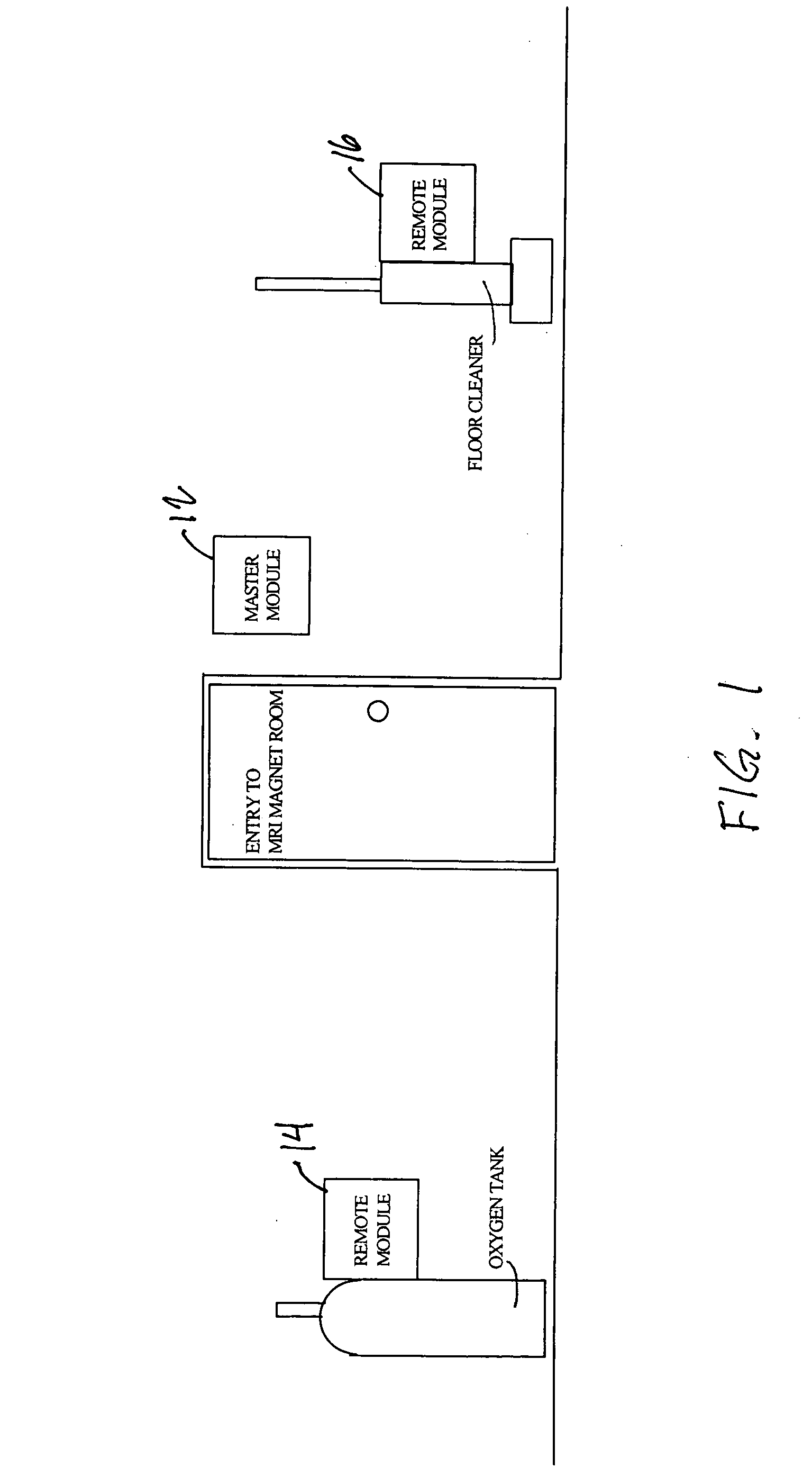Radio frequency warning system for ferromagnetic threats
a radio frequency warning and ferromagnetic technology, applied in the direction of electric signalling details, instruments, transportation and packaging, etc., can solve the problems of mri patients being potentially lethal, mri instruments being damaged, and pipe wrenches posing a threat of great harm to patients undergoing mri, and causing the death of patients
- Summary
- Abstract
- Description
- Claims
- Application Information
AI Technical Summary
Benefits of technology
Problems solved by technology
Method used
Image
Examples
second embodiment
[0074]In an alternative second embodiment of the invention, the threat warning system can operate using a one-way radio link, where the master module contains only a receiver and each of the remote modules contains only a transmitter. In this embodiment, the master module initiates an alarm if it receives a radio signal from a remote module that is above the predetermined threshold signal strength. This embodiment does not provide the redundancy described above for the preferred embodiment.
[0075]FIG. 10 shows a flow diagram of the functional system 200 of a typical remote module according to the aforementioned alternative second embodiment. This embodiment includes a Tx control 222, an encoder 232, a remote gender ID unit 247, a system ID unit 248, an RF transmitter 226, and an antenna 228.
[0076]The Tx control 222 initiates and controls the radio transmission. The period between transmissions is a pseudo-random time and is approximately one half second.
[0077]The encoder 232 formats ...
third embodiment
[0088]FIG. 12 illustrates the first means of initiating an alarm, via the signal strength, in an alternative If a radio signal is received from the same system identification, from an opposite gender of radio unit, and is above a pre-determined receive threshold, then a local alarm condition is activated at the receiving module. The circles represent the distance corresponding to a predetermined received signal strength at which an alarm is to be generated. A local alarm condition can result in activating the local visible and audible alarm outputs associated with the receiving module. In this embodiment, the master module 12′ transmits at a first frequency, denoted as “frequency 1”, and listens at a second frequency, denoted as “frequency 2”. Also, the remote modules 14′, 16′ transmit at frequency 2 and listen at frequency 1.
[0089]FIG. 13 shows a flow diagram of the functional system 700 of a typical remote module 14′, 16′ according to the alternative third embodiment. The Tx cont...
fourth embodiment
[0133]FIG. 18 shows basic radio message formats for the remote and master modules of the alternative fourth embodiment, which contains a synchronization pattern, a threat warning system ID field, an alarm status field, and a source ID field. In the signal from the remote unit to the master unit, the source ID field gives the unique identifier of the remote module transmitting the signal (the signal source ID), so that the master unit can identify any remote unit which approaches too close. In the signal from the master unit to the remote unit, the source ID field identifies any remote module which has approached too close and caused an alarm at the master module (the alarm source ID). If two or more master modules were to be used in a system in this embodiment, both the master module and the remote module would generate signals with both a signal source ID field and an alarm source ID field.
PUM
 Login to View More
Login to View More Abstract
Description
Claims
Application Information
 Login to View More
Login to View More - R&D
- Intellectual Property
- Life Sciences
- Materials
- Tech Scout
- Unparalleled Data Quality
- Higher Quality Content
- 60% Fewer Hallucinations
Browse by: Latest US Patents, China's latest patents, Technical Efficacy Thesaurus, Application Domain, Technology Topic, Popular Technical Reports.
© 2025 PatSnap. All rights reserved.Legal|Privacy policy|Modern Slavery Act Transparency Statement|Sitemap|About US| Contact US: help@patsnap.com



